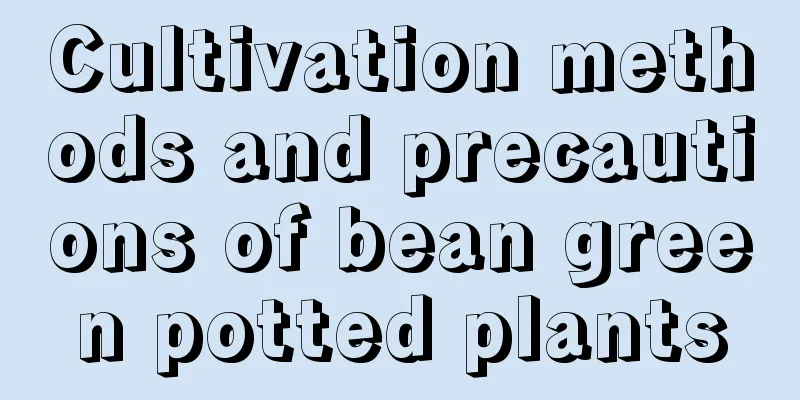Cultivation methods and precautions of peacock arrowroot

Soil selectionLoose, fertile, well-drained, slightly acidic loam rich in humus is suitable for peacock alocasia potting. It can usually be mixed with 3 parts of leaf mold, 1 part of peat or sawdust, and 1 part of sand, and a small amount of bean cake can be added as base fertilizer. Avoid using heavy garden soil. When potting, first put a 3 cm thick layer of coarse sand on the bottom of the pot as a drainage layer to facilitate drainage. Water requirementsSufficient water should be given during the growing period, especially in summer and autumn. In addition to keeping the soil in the pot moist, you should also spray water on the leaves frequently to cool down and retain moisture. It requires a higher air humidity, preferably 70% to 80%. Avoid dry air and dry soil in the pot, but do not allow water to accumulate. Water should be controlled after late autumn to help the plant resist the cold and survive the winter. Maintain a dry environment in winter. If it is too humid, the base leaves will turn yellow and burn, affecting its ornamental value. Lighting requirementsDuring the growing season from May to September, it should be placed in a shaded or semi-shaded place, maintain a light transmittance of 40%-60%, and avoid direct sunlight. Too strong light or dry air can easily cause the leaf edges and tips to burn, and the leaf patterns to become dull and lifeless. However, the light should not be too weak. If it is placed in a dark room for a long time, the temperature is low and the light is insufficient, it will also grow weak, which is not conducive to the formation of leaf color and loses the unique metallic luster of the leaves. Direct sunlight through glass is acceptable in winter. Fertilization requirementsWhen the peacock plant lacks fertilizer, the plant will be obviously shorter, the leaves will be dull in color, and the golden luster will not be bright. Apply thin liquid fertilizer once every 20 days during the growing season. The ratio of nitrogen, phosphorus and potassium should be 2:1:1, which can make the leaves shiny and bright. Avoid excessive nitrogen fertilizer proportion. For example, spray 0.2% liquid fertilizer directly on the leaves every 10 days, which is extremely beneficial for germination and growth. Stop rotating fertilizer in winter and summer. PrecautionsThe roots of the peacock plant are shallow, so it is advisable to use a large shallow pot. This will not affect the growth of the roots, and the leaves will unfold during the day without appearing top-heavy. The potting soil should be loose, breathable, well-drained, nutrient-rich and slightly acidic. The peacock plant is usually repotted when it is divided in spring, and it should be repotted every 1 to 2 years. When repotting, new culture soil must be added, and the remaining roots and leaves must be cut off and replanted to facilitate growth. Peacock plant has fewer diseases and pests, but if ventilation is poor and the air is dry, scale insects may cause damage. Use imidacloprid series drugs to spray for prevention and control. |
<<: Appreciation of Rose Varieties (Pictures and Text)
>>: The meaning of tulips in different colors
Recommend
What kind of soil is good for potted weeping angel
The principle of soil use for Dripping Guanyin Wh...
How to grow Epiphyllum so that it blooms
Epiphyllum blooms Epiphyllum usually blooms from ...
How to grow the genus Artemisia (is it better to use a high pot or a shallow pot for the genus Artemisia)
The variegated Master is relatively rare. There a...
Is Sea Tiger Orchid poisonous?
1. Is it poisonous? Sea tiger orchid is not poiso...
If you grow it like this, the Clivia will bloom every year. If it doesn’t, come to me!
1. Clivia does not bloom Excessive light exposure...
Remedies for Yellowing Yew Leaves
Yew is loved by people for its elegant shape, sle...
How to care for Clivia in summer
1. Sunshade and ventilation After entering summer...
What can I do if the mountain tortoise does not germinate?
Mountain tortoise is a vine plant that germinates...
What are the benefits of keeping rubber trees at home?
Green vacuum cleaner Although the rubber tree is ...
How to grow Nine-headed Lion Grass
1. Soil Nine-headed lion grass is more suitable f...
How to grow the hydroponic fortune tree to make it more vigorous
The money tree is relatively easy to keep and has...
Diseases and Pests of Citron and Their Control
Diseases of Buddha's Hand Sooty Disease of Bu...
Paphiopedilum cultivation methods and precautions
1. Maintenance methods 1. Temperature: Paphiopedi...
How long does it take for Wisteria cuttings to take root? The fastest way to root cuttings
Wisteria cutting rooting time Wisteria can be pro...
What kind of water is better for watering flowers (what kind of water is better for indoor flowers to grow well)
Nowadays, many people like to grow some flowers a...









